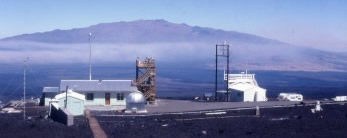WEBCAST OF THE JUNE 5, 2012 Transit of Venus
On June 5, 2012, the Exploratorium webcast the 6.5-hour transit of Venus live from the Mauna Loa Observatory in Hawaii.
Video clips showing the beginning (1st and 2nd contact) and end (3rd and 4th contact) of the transit, as well as a highlights clip that includes sunspots and solar prominences, are now viewable here.
The videos show the transit through three different telescopes. The yellow-
looking sun was imaged through a white-light telescope, filtered only to decrease
the sun's brightness. The violet-hued sun is the result of a calcium filter. Calcium
ions emit wavelengths in the ultraviolet part of the spectrum, which the camera
interprets for us. The red-colored sun was shot through a hydrogen-alpha filter,
which only allows red light emitted by hydrogen to reach the camera.
As the video signal was received at the museum, Exploratorium composer
Wayne Grim converted it into a
sound composition
.





